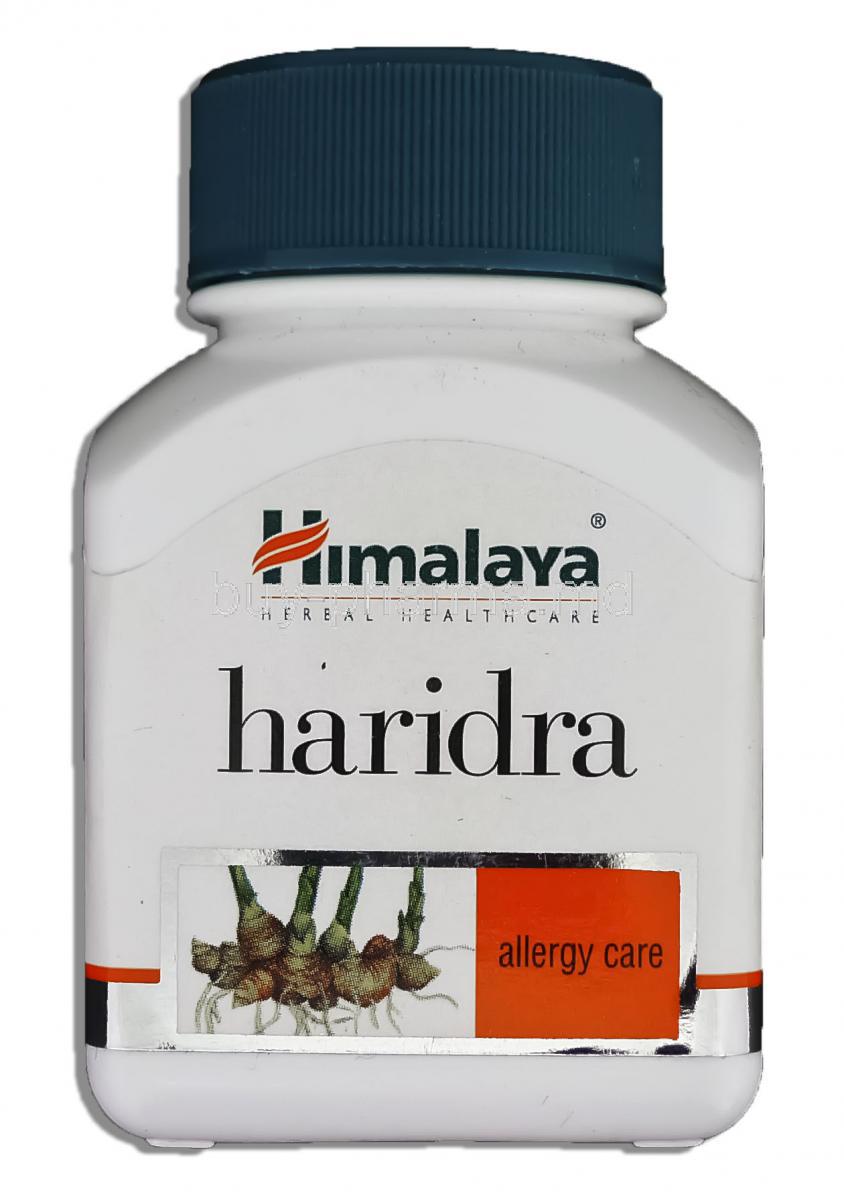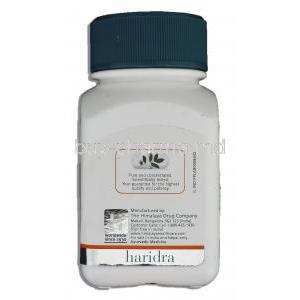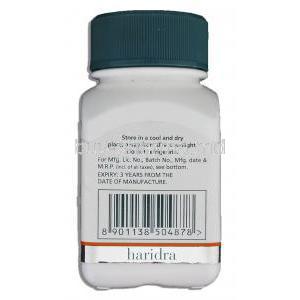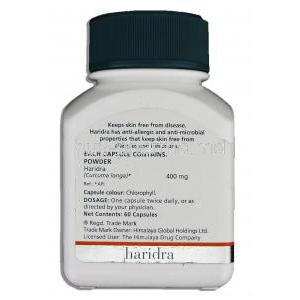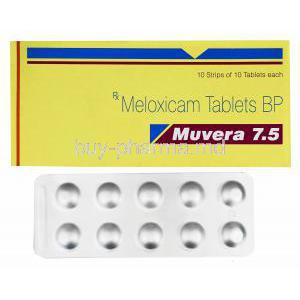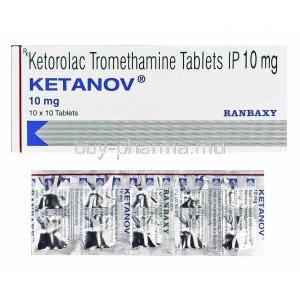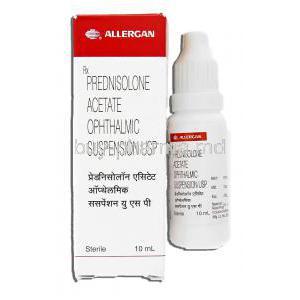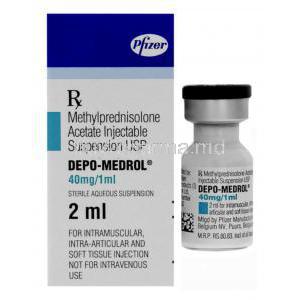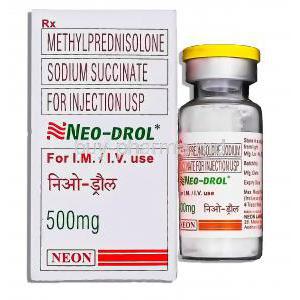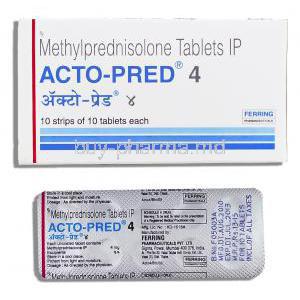1. Introduction to Himalaya Haridra Allergy Care
Haridra, known scientifically as Curcuma longa, holds an esteemed position in Ayurvedic medicine for its robust anti-inflammatory and detoxifying capabilities. Traditionally employed to manage a wide spectrum of ailments—from skin disorders to internal inflammation—it has earned its place as a cornerstone herb in holistic therapies.
Himalaya, a globally respected herbal brand, has consistently delivered science-backed botanical solutions. Their Haridra Allergy Care supplement exemplifies their commitment to purity, safety, and therapeutic efficacy.
This supplement is formulated to relieve allergy symptoms, fortify immune defenses, and restore balance in inflammatory conditions. Suitable for adults seeking natural allergy relief, it caters to individuals with sensitivities, seasonal allergic rhinitis, or chronic skin flare-ups.
2. Key Medicinal Uses of Himalaya Haridra Allergy Care
2.1 Relief from Seasonal Allergies and Allergic Rhinitis
- Targets common allergy symptoms: sneezing, nasal congestion, watery eyes, and postnasal drip
- Facilitates sinus drainage and reduces mucosal swelling
Haridra works systemically to modulate histamine release, making it ideal for managing spring and fall allergies.
2.2 Management of Skin Allergies and Inflammatory Skin Conditions
- Provides relief in urticaria (hives), eczema, and contact dermatitis
- Reduces itching, erythema, and swelling
Its antimicrobial action also supports recovery from secondary infections caused by scratching or chronic lesions.
2.3 Adjunct Therapy for Autoimmune and Inflammatory Disorders
- Used off-label in rheumatoid arthritis, psoriasis, and ulcerative colitis
- Helps regulate pro-inflammatory cytokine activity
Its immunomodulatory role may contribute to reduced flare frequency and overall inflammation burden.
2.4 General Immune System Support and Antioxidant Protection
- Enhances immune surveillance and adaptive response
- Neutralizes free radicals, supporting cellular integrity
Regular use may contribute to improved resistance against environmental stressors and immune fatigue.
3. How Himalaya Haridra Works to Alleviate Allergic Symptoms
The primary bioactive compound in Haridra is curcumin, a polyphenol with potent pharmacological properties.
- Inhibits histamine release from mast cells and basophils
- Suppresses pro-inflammatory mediators like TNF-α and IL-6
- Exerts antioxidative stress modulation in immune pathways
These combined actions result in fewer allergy symptoms and a more balanced inflammatory response.
4. Composition and Active Herbal Ingredients
4.1 Primary Ingredient: Haridra (Curcuma longa)
- Standardized curcumin extract ensures consistent therapeutic dose
- Superior bioavailability compared to raw dietary turmeric
The formulation leverages advanced extraction techniques to deliver bioactive curcuminoids in optimal concentrations.
4.2 Other Herbal and Supportive Ingredients (if applicable)
- Formulated in vegetarian capsules with inert excipients
- Free from artificial additives, preservatives, and common allergens
Designed to maximize stability and absorption while maintaining purity standards.
5. Recommended Dosage and Administration Guidelines
- Typical adult dose: 1 capsule twice daily with meals
- For acute episodes, dosage may be adjusted under professional guidance
Consistency is crucial—continued use for 4 to 6 weeks yields optimal results. Elderly and medically complex individuals may require tailored regimens.
6. Common and Potential Side Effects of Himalaya Haridra
6.1 Frequently Reported Mild Side Effects
- Digestive disturbances such as bloating or mild diarrhea
- Occasional headaches or lightheadedness
- Skin irritation if co-applied topically
6.2 Less Common or Rare Adverse Reactions
- Allergic reactions including rash or respiratory difficulty
- Elevated liver enzymes in predisposed individuals
Adverse effects are typically rare and dose-dependent. Discontinue use if severe reactions occur.
7. Off-Label and Traditional Ayurvedic Applications
- Supports metabolic balance in prediabetes and insulin resistance
- Explored in cognitive health due to its neuroprotective properties
- Applied in liver detox protocols to reduce oxidative liver damage
These traditional and emerging uses highlight Haridra’s versatility in integrative care settings.
8. Drug, Food, and Supplement Interactions
- May potentiate effects of blood thinners like warfarin or aspirin
- Can enhance efficacy of other anti-inflammatory botanicals
- CYP450 interaction potential—monitor if on multiple medications
Physician supervision is advisable for patients on complex pharmaceutical regimens.
9. Warnings and Contraindications for Use
- Not advised in those with obstructed bile ducts or gallstones
- Contraindicated in individuals allergic to turmeric or related species
- Use with caution in bleeding disorders or before surgery
Medical consultation is essential before initiating use in high-risk individuals.
10. Careful Administration and Monitoring Guidelines
- Long-term users should undergo periodic liver function tests
- Care advised in those with hepatic insufficiency or GI ulcer history
- Evaluate risks and benefits before co-administering with immunosuppressants
Thoughtful monitoring enhances safety and optimizes therapeutic outcomes.
11. Important Safety Precautions and Label Instructions
For individuals with persistent or chronic allergic conditions, it is crucial to consult a qualified healthcare provider before initiating Himalaya Haridra Allergy Care. This ensures the supplement is used safely alongside conventional treatments and within the context of existing medical conditions.
- Follow the recommended dosage as stated on the product label or as prescribed by a healthcare professional.
- Store the capsules in a cool, dry place away from direct sunlight and moisture.
It is essential to understand that Haridra is a supportive herbal remedy—not a replacement for clinically indicated antihistamines, corticosteroids, or emergency allergy medications. Its role is adjunctive, not curative in acute allergic scenarios.
12. Use in Special Populations
12.1 Administration in the Elderly
Older adults may require tailored dosing due to age-related changes in hepatic and renal metabolism. Reduced clearance rates and polypharmacy increase the need for medical supervision.
- Initiate therapy at the lower end of the dosing spectrum.
- Monitor for signs of hepatic or renal stress, particularly in those with comorbidities.
12.2 Use in Pregnant Women and Nursing Mothers
There is a lack of well-controlled clinical studies evaluating the safety of Haridra in pregnant or lactating individuals. Curcumin, a primary active compound, is known to possess mild uterotonic properties that may pose a risk during pregnancy.
- Use is not recommended unless clearly advised by a physician.
- Breastfeeding mothers should consult their healthcare provider prior to use due to unknown excretion levels into breast milk.
12.3 Use in Pediatric Patients and Adolescents
While Haridra has traditional use in pediatric care within Ayurveda, standardized extracts require cautious application. Safety and efficacy data in children remain limited.
- Not advised for use in children under 12 years of age without medical supervision.
- Monitor for hypersensitivity reactions, especially in children with known food or pollen allergies.
13. Overdose Symptoms and Emergency Measures
Though rare, acute overdose of Himalaya Haridra Allergy Care may present with gastrointestinal and systemic symptoms:
- Nausea, loose stools, or abdominal cramping
- Dizziness or fatigue from systemic overload
- Potential hepatotoxicity at excessive dosages over prolonged periods
In the event of suspected overdose, discontinue use immediately and seek professional medical assistance. Supportive management includes hydration, gastrointestinal decontamination (e.g., activated charcoal), and monitoring of liver enzymes as necessary.
14. Storage Conditions and Handling Instructions
To preserve the integrity and efficacy of Himalaya Haridra Allergy Care, proper storage is essential:
- Store at room temperature, ideally below 25°C (77°F).
- Avoid exposure to high humidity and direct sunlight.
- Keep the product out of reach of children and pets.
Always check the expiry date before consumption. Do not use if the capsule shell is discolored, damaged, or malformed. Unused or expired supplements should be discarded responsibly, preferably through local pharmaceutical disposal programs to avoid environmental contamination.
Himalaya Haridra Allergy care FAQ
- What is the use of Haridra Himalaya?
- What is Haridra used for?
- Are haridra and turmeric the same?
- What are the side effects of Haridra Khanda?
- What is the pharmacological action of Haridra?
- How do you take Himalaya Haridra?
- What are the contraindications for Haridra?
- How does haridra work?
- What is the common name for haridra?
- Is Himalaya haridra good?
What is the use of Haridra Himalaya?
Haridra capsules are commonly prescribed for individuals with diabetes to manage and prevent skin allergies and infections while also supporting the health of the retina, kidneys, blood vessels, and nerve cells affected by the condition.
What is Haridra used for?
It is commonly utilized for its antioxidant properties. It has a range of benefits including anti inflammatory effects and antiseptic properties that can help cleanse the blood and alleviate allergies.
Are haridra and turmeric the same?
Turmeric is often referred to as "Haldi," a term originating from the Sanskrit word 'Haridra.
What are the side effects of Haridra Khanda?
Haridrakhanda is generally deemed safe if consumed in the recommended doses.
What is the pharmacological action of Haridra?
Its properties of being antimicrobial and anti-inflammatory, along with other qualities, contribute to its ability to offer protection against factors.
How do you take Himalaya Haridra?
Remember to consume two Himalaya Haridra tablets twice a day following your meals.
What are the contraindications for Haridra?
People who have allergies to turmeric or neem should steer clear of it as those, with serious liver or kidney issues.
How does haridra work?
It reduces pain and swelling by blocking the arachidonic acid cascade through both the lipoxygenase and cyclooxygenase (CO X ) pathways.
What is the common name for haridra?
Curcuma longa Linn
Is Himalaya haridra good?
Enhances the appearance and texture of the skin. It is helpful in managing skin conditions such as allergic reactions like hives and dermatitis, issues like melasma and rhinitis caused by allergies, or skin bumps with fluid discharge. Additionally, it is used to alleviate itching related to skin disorders like pruritus and address conditions like blisters and fungal infections on the skin. It serves as a shield against infections along with hives and blisters.

